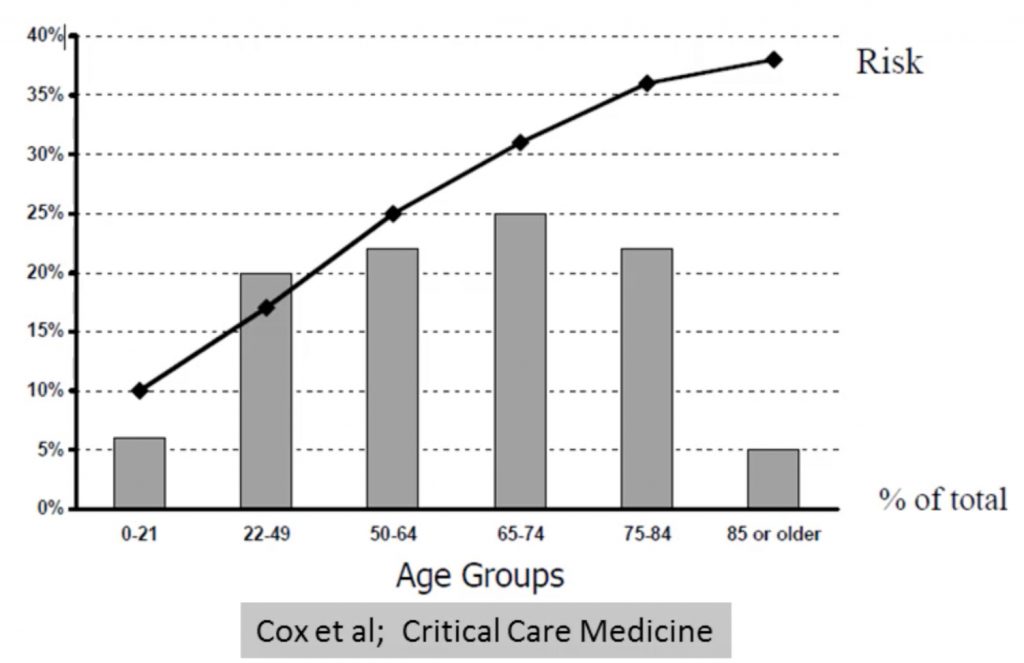Today we welcome a local legend: H. Neal Reynolds, MD. Dr. Reynolds is an Associate Professor of Medicine at the University of Maryland School of Medicine as well as the Associate Director of the Shock Trauma Center’s Multi-Trauma ICU. Today Dr. Reynolds provides us with an in-depth look at the world of the chronically ill. Every ICU has them, now it’s time to have a primer on the proper management of this issue before it becomes too late!
Clinical Pearls assisted by Kamel Gharaibeh, MD
Definition
- “Patients who have survived the acute phase of critical illness but remain dependent on mechanical ventilation and possibly other life sustaining therapies”
- Patients who is dependent on one of the following:
- Hemodialysis, vasopressors, feeding tubes
- Intensive nursing
- Prolonged ventilator support
- Complex wounds and resistant infections
- Prolonged rehabilitation needs
- Malnourished
- Confused
- Recurrent infections
- Most chronically critically ill patients are older adults who have underlying comorbid conditions and develop sepsis and other acute comorbidities with treatment for acute medical, surgical, neurologic, or cardiac critical illness.
Risk Stratification
- The most important risk factor is age.
- Older people are at risk of developing chronic critical illness (CCI) and < 5% of the older patients get discharged home
- Data shows: patients who are highly dependent at 3 months, NONE have a great outcome
- CCI account for 10% of mechanically ventilated patients
- BUT account for 20-40% of ICU days
- Growth in need for prolonged mechanical ventilation is increasing and its very expensive. It costs around 60k/year
- CCI account for 10% of mechanically ventilated patients
- If a patient develop delirium in the ICU, the chance of survival goes down without clear explanation
- Injury Severity Score (ISS) is associated with increase mortalitu
- Multiple hit theory
- With each hit (trauma, infection, bleeding, etc…), the reserve gets less and less and if you don’t have reserve, you can’t react appropriately to a bad infection
- Organ reserve declines with age especially heart, kidney, pulmonary, and liver
- ex: FEV1 decreases approximately 30ml/year
Futile Care
- Futile Critical Care defined as the following:
- Therapeutic burdens far outweigh benefits
- Therapy will never reach patient goals
- Death is imminent
- Patient would never survive outside the ICU
- Studies showed that around 20% of ICU patients are futile critical care
- What is required: determine how/when these patients transition to prolonged critical illness
Management and prevention of CCI
- HUGE impact on family dynamics/behavioral state
- More than Alzheimer’s disease and spinal cord injuries
- Require intense involvement and reassurance
- Managed with multidisciplinary family meetings and honest feedback on medical status
- More than Alzheimer’s disease and spinal cord injuries
- Critical care medicine cost 20% of health care cost, 1% of the GDP.
- Mean ICU daily cost is $ 4004
- Managed best with simple recognition and early planning for end of life/goals of care
Suggested Reading
- Unroe M, Kahn JM, Carson SS, Govert JA, Martinu T, Sathy SJ, Clay AS, Chia J, Gray A, Tulsky JA, Cox CE. One-year trajectories of care and resource utilization for recipients of prolonged mechanical ventilation: a cohort study. Ann Intern Med. 2010 Aug 3;153(3):167-75. [Pubmed Link]
- Zilberberg MD, de Wit M, Pirone JR, Shorr AF. Growth in adult prolonged acute mechanical ventilation: implications for healthcare delivery. Crit Care Med. 2008 May;36(5):1451-5. [Pubmed Link]
- Lin SM, Liu CY, Wang CH, Lin HC, Huang CD, Huang PY, Fang YF, Shieh MH, Kuo HP. The impact of delirium on the survival of mechanically ventilated patients. Crit Care Med. 2004 Nov;32(11):2254-9. [Pubmed Link]
- Osler T, Glance L, Buzas JS, Mukamel D, Wagner J, Dick A. A trauma mortality prediction model based on the anatomic injury scale. Ann Surg. 2008 Jun;247(6):1041-8. [Pubmed Link]
- Nelson JE, Cox CE, Hope AA, Carson SS. Chronic critical illness. Am J Respir Crit Care Med. 2010 Aug 15;182(4):446-54. [Pubmed Link]







